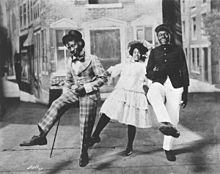African-American musical theater
This section needs additional citations for verification. (October 2021) |
| Part of a series on |
| African Americans |
|---|
| This article is part of a Theater of the United States |
 |
| Lists |
|---|
|
| By State |
|
United States portal |
African-American musical theater includes late 19th- and early 20th-century
Early history
The
Before the late 1890s, the image portrayed of
was common. Minstrel shows were often performed in early history and were inspired by black music. These shows were first performed by white people who used black face in the 1800s. Many of these performers wore old ripped clothing, some actually stolen from slaves, to “represent” the enslaved African Americans. Along with the clothing, the white performers portrayed black people out to be lazy, thieves, and dumb.The Hyers Sisters have been credited with creating the first American musicals in the 1870s. Trained opera singers, they toured the United States for 20 years, performing 'comic operas' that broke with minstrel show stereotypes and told stories about slavery and freedom. [2] Another pioneering Black touring group was Sherman H. Dudley's Smart Set Company, whose musical comedies in the early 1900s bridged the gap between old Minstrel-style stereotypes and more upscale, authentic and self-referential humour. [3]
Bob Cole and brothers
Cole and the Johnson brothers went on to create musicals such as The Belle of Bridgeport, The Red Moon (with Joe Jordan), The Shoo-Fly Regiment, In Newport, Humpty Dumpty, and Sally in Our Alley (featuring Bob Cole's "Under The Bamboo Tree"). Bob Cole's suicide in 1911 ended "one of the promising musical comedy teams yet seen on Broadway". [citation needed]
National recognition

Bert Williams and George Walker, called the "Two Real Coons", found fame in 1896 with a musical farce called The Gold Bug. The duo's performance of the cakewalk was successful. Williams met Walker in San Francisco in 1893, while they played Dahomeyans in an exhibit of the California Midwinter International Exposition of 1894. They played different venues while putting together their act.[citation needed]
Williams and Walker were dropped from "
Crossover shows
By 1911, Ernest Hogan, Bob Cole, and George Walker had died. Will Marion Cook and the Johnson brothers, James and J. Rosamond, had pursued new careers and Bert Williams moved to the Ziegfeld Follies and black musical theater went into a hiatus.[7]
In 1915 ragtime composer Scott Joplin attempted to stage an opera Treemonisha in Harlem but the show was a financial and critical failure and Joplin was ruined and retreated into retirement until his death in 1917.[citation needed]
In May 1921, the surprising hit
In 1921, Miller and Lyles appeared in a
Rang Tang
Rang Tang was premiered July 12, 1927, on Broadway at the Royale Theater and ran for 119 performances, including a 14-week overrun, finishing at the Majestic October 24, 1927.[citation needed]
Lew Leslie's Blackbirds
In 1928, white producer and director
Porgy and Bess, the WPA, The Swing Mikado, and Carmen Jones
However, one black musical comedy succeeded and twisted the new realm of musical theater, The Swing Mikado (1937), a "modernization" of Gilbert and Sullivan’s classic operetta, The Mikado. This was followed by The Hot Mikado (1939).[13] Another modern version of the classics was Oscar Hammerstein II's Broadway musical Carmen Jones (1943), a version of Georges Bizet’s Carmen with an all-black cast.[14]
Present day
In the late 20th and 21st century, predominantly Black musical theatre shows became more common. Notable shows include Once on This Island, The Color Purple, MJ the Musical, Dreamgirls, The Lion King, Tina: The Tina Turner Musical, Ain't Too Proud, Passing Strange, and The Wiz. Sister Act is led by a Black character while Hairspray features multiple Black characters, ensemble members and a story about integration. Michael R. Jackson's A Strange Loop won the Pulitzer Prize for Drama in 2020, becoming the first African American musical to win this award.[citation needed]
Further reading
- Craig R. Prentiss, Staging Faith: Religion and African American Theater from the Harlem Renaissance to World War II. New York: New York University Press, 2014.
- Allen L. Woll, Black Musical Theater: From Coontown to Dreamgirls. Baton Rouge, LA: Louisiana State University Press, 1989.
See also
- The Frogs (club)
- African American music
- Black Vaudeville
References
- ^ Allen L. Woll, Black Musical Theater: From Coontown to Dreamgirls. Baton Rouge, LA: Louisiana State University Press, 1989; pg. 1.
- ^ "Sacramento Sisters Originators of the First American Musical". CBS News Sacramento. CBS News. 12 February 2021. Retrieved January 29, 2024.
- ISBN 978-1-60473-148-4. Retrieved February 16, 2024.
- ^ Woll, Black Musical Theater, pg. 15.
- ^ Woll, Black Musical Theater, pp. 33-41.
- ^ Woll, Black Musical Theater, pg. 48.
- ^ Woll, Black Musical Theater, pg. 50.
- ^ Woll, Black Musical Theater, pg. 73.
- ^ "Lew Leslie". Internet Broadway Database. The Broadway League. Retrieved 2009-03-10.
- ^ Woll, Black Musical Theater, pg. 98.
- ^ Woll, Black Musical Theater, pg. 97.
- ^ Woll, Black Musical Theater, pg. 175.
- ^ Woll, Black Musical Theater, pp. 178–184.
- ^ Woll, Black Musical Theater, pg. 189.
